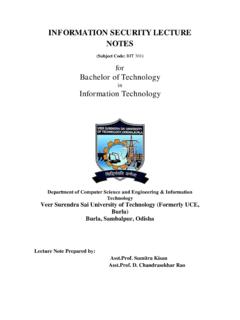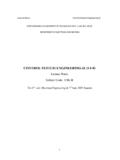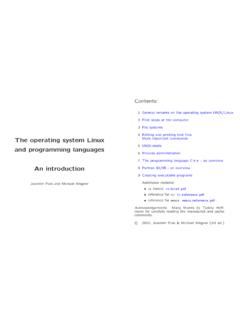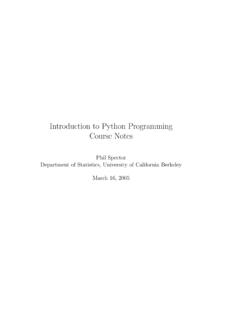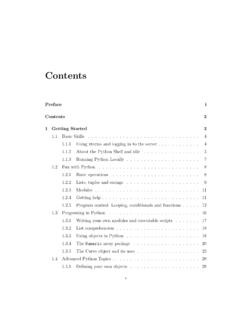Transcription of LECTURE NOTE on PROGRAMMING IN “C”
1 LECTURE NOTEonPROGRAMMING IN C COURSE CODE: MCA 101 ByAsst. Professor Mrs Etuari OramAsst. Prof. Mr Bighnaraj Naik SYLLABUSM odule IC Language set, Identifiers, keyword, data types, Constants and variables, statements, expression, operators, precedence of operators, Input-output, Assignments, control structuresdecision making and -IIArrays, Functions and Strings: Declaration, manipulation and String handling functions, monolithic vs.
2 Modular programs, user defined vs. standard functions, formal vs. actual arguments, function category, function prototypes, parameter passing, recursion, and storage classes: auto, extern, global, IIIP ointers, Structures, Unions, File handling:Pointer variable and its importance, pointer arithmetic, passing parameters, Declaration of structures, pointer to pointer, pointer to structure, pointer to function, union, dynamic memory allocation, file managements. 2 *Under revision CONTENTS Module: 1 LECTURE 1: Introduction to C LECTURE 2: Structure of C, compilation, execution LECTURE 3:character set, identifiers, keywords LECTURE 4: constants, variables LECTURE 5: expression, operators LECTURE 6: operators LECTURE 7: loops: do while, while LECTURE 8.
3 For loop, break, continue statement LECTURE 9: control Statements LECTURE 10: nesting of if , if else ladderLecture 11: arrays LECTURE 12: 2-diamensional arrayModule: 2 3 *Under revision LECTURE 13: String library functions LECTURE 14: functions, categories LECTURE 15: functions categories LECTURE 16: Actual arguments and Formal arguments, call by value call by reference LECTURE 17:local, global, static variable LECTURE 18: monolithic vs modular PROGRAMMING , Storage classes LECTURE 19:storage class , pointer LECTURE 20: pointer comparison, increment decrement LECTURE 21: precedence level of pointer, pointer comparison LECTURE 22.
4 Pointer to pointer, pointer to structure LECTURE 23: pointer initialization, accessing elements Module: 3 LECTURE 24: size of Structure in, array vs structure, array within structure LECTURE 25: passing structure to function, Nested Structure LECTURE 26: Union LECTURE 27: nesting of unions, dynamic memory allocationLecture 28: dynamic memory allocation LECTURE 29: dynamic array, file LECTURE 30: file operation LECTURE 31: file operation on stringLecture 32: LECTURE 33: 4 *Under revision LECTURE Note.
5 1 Introduction to C C is a PROGRAMMING language developed at AT & T s Bell Laboratories of USA in 1972. It was designed and written by a man named Dennis Ritchie. In the late seventies C began to replace the more familiar languages of that time like PL/I, ALGOL, etc ANSI C standard emerged in the early 1980s, this book was split into two titles: The original was still called PROGRAMMING in C, and the title that covered ANSI C was called PROGRAMMING in ANSI C. This was done because it took several years for the compiler vendors to release their ANSI C compilers and for them to become ubiquitous.
6 It was initially designed for PROGRAMMING unix operating system. Now the software tool as well as the C compiler is written in C. Major parts of popular operating systems like Windows, unix , Linux is still written in C. This is because even today when it comes to performance (speed of execution) nothing beats C. Moreover, if one is to extend the operating system to work with new devices one needs to write device driver programs. These programs are exclusively written in C. C seems so popular is because it is reliable, simple and easy to use.
7 Often heard today is C has been already superceded by languages like C++, C# and Java. Program 5 *Under revision There is a close analogy between learning English language and learning C language. The classical method of learning English is to first learn the alphabets used in the language, then learn to combine these alphabets to form words, which in turn are combined to form sentences and sentences are combined to form paragraphs.
8 Learning C is similar and easier. Instead of straight-away learning how to write programs, we must first know what alphabets, numbers and special symbols are used in C, then how using them constants, variables and keywords are constructed, and finally how are these combined to form an instruction. A group of instructions would be combined later on to form a program. So a computer program is just a collection of the instructions necessary to solve a specific problem. The basic operations of a computer system form what is known as the computer s instruction set.
9 And the approach or method that is used to solve the problem is known as an for as PROGRAMMING language concern these are of two types. 1) Low level language 2) High level languageLow level language: 6 *Under revision Low level languages are machine level and assembly level language. In machine level language computer only understand digital numbers in the form of 0 and 1.
10 So, instruction given to the computer is in the form binary digit, which is difficult to implement instruction in binary code. This type of program is not portable, difficult to maintain and also error prone. The assembly language is on other hand modified version of machine level language. Where instructions are given in English like word as ADD, SUM, MOV etc. It is easy to write and understand but not understand by the machine. So the translator used here is assembler to translate into machine level. Although language is bit easier, programmer has to know low level details related to low level language.




